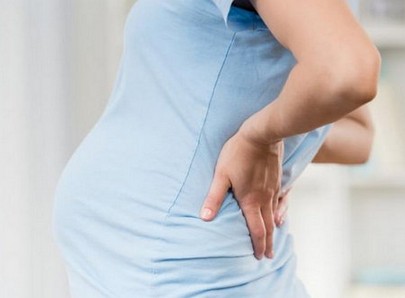Lower Back Pain During Pregnancy

Contents:
- Low Back Pain in Pregnancy
- Causes of Lower Back Pain During Pregnancy
- How to Overcome Back Pain During Pregnancy
- When You Should Urgently See the Doctor
- How Doctors Treat Pain?
Low Back Pain in Pregnancy
It’s quite rare for a pregnant woman not to have lower back pains at least once during the pregnancy. With the belly growing rounder, the pressure on the spine increases. There are other reasons for the back pain during the pregnancy.
In any case, the expectant mom should tell all her complaints to her doctor:
- One of the reasons for the back pain is that the bones and ligaments are preparing for the upcoming delivery. Another reason can be a pyelonephritis, but only the doctor can find the real cause.
- In case of spinal problems (osteochondrosis or scoliosis) a set of special exercises can be performed along with other non-medical treatments. The medications that are usually used to treat osteochondrosis are prohibited during pregnancy.
- Many women with lower back pain find relief in wearing bandage, but this should be discussed with the doctor.
Causes of Lower Back Pain During Pregnancy
Why the Lower Back Pain Occurs During Pregnancy? In the first days after conceiving, the ligaments in the bones and internal organs start to prepare for the birth. The ovaries and placenta start producing the hormone relaxin, that makes the connectives tissues soft and elastic.
This is necessary for the pelvis to be more flexible for the baby birth. These changes in the body can cause the lower back pains.
Weight gain can trigger that pain too. The spine is not up to carrying the increased weight, especially if the woman had orthopaedic problems (a spinal curvature or osteochondrosis) before the pregnancy.
Lower back pain can be caused by the pyelonephritis, a kidney inflammation. It comes together with fever, swelling, headache, increased blood pressure and frequent urination.
The doctor should be called in case of a lower back pain with a temperature rise. If the above symptoms come with a light bleeding, it is a cause for alarm.
How to Overcome Back Pain During Pregnancy
In order to relieve back pain during pregnancy, you need to follow a few simple rules:
- Wear shoes with low heels. As well as high heels, the absence of heels is not recommended.
- Do physical jerks for pregnant women. Pregnancy is not a reason to spend most of your time in the bed. The following is optimal: specialized water aerobics and Yoga for pregnant women.
- Be aware of your limits. If it's hard to do something on your own, just ask for help.
- The bed, on which you sleep, should have a rigid base. The recommended sleeping pose is lateral position with a pillow between the knees to maintain your growing belly.
- The following is permitted: a massage of tender areas (including a gentle back massage by your beloved husband), an application of "cold" and "heat". The use of warmer with ice or a package of frozen vegetables for 20 minutes 3 times a day during 2-3 days, then 2-3 days use the warmer with warm water in the same way. You should not apply neither heat nor cold to the abdomen.
- Recommendations are the following: an acupuncture and an osteopath counseling. The specialist must have documents about the received corresponding training and have the right to apply any methods to pregnant women.
- Your doctor may prescribe a short course of medicated pain relief. The use of acetaminophen (paracetamol) is considered the safest one.
When You Should Urgently See the Doctor

In the following cases, the pain syndrome can "mask" some more serious health problems:
- some suddenly appeared severe pain;
- a pain, which increases or lasts more than two weeks;
- an attack-like, "rhythmic" pain;
- a pain accompanied by the bloody spotting from the genital tract;
- a pain on the background of a fast temperature rise or painful urination.
Other causes of low back pain during pregnancy are the following:
Back pain can be associated with pancreatitis, pyelonephritis, urolithiasis (a stone in the kidney is mobile and traumatize the urinary tract`s mucosa causing pain).
1. Pancreatitis is an inflammation of the pancreas. Its development is provoked by the outflow of bile, any failure to comply with the diet, in particular, the hearty meat and fatty foods, alcohol, hereditary predisposition, stress. However, be aware that during pregnancy, this disease is fortunately quite rare. The acute pancreatitis manifests in the sharp pains in the upper abdomen (anticardium, right or left hypochondrium), lower back, the pain is often of a girdling type. There is often a vomiting, altered defecation pattern, low blood pressure. In this case, you need to call an ambulance or go to the hospital.
The laboratory tests of blood and urine, ultrasound, fiberoptic gastroduodenoscopy, MRI, etc. are used to diagnose the disease. Most often, the treatment is conservative, in the hospital. The strict diet, medications to normalize the function of the pancreas, as well as anti-inflammatory and anaesthetics are assigned. In case of severe illness, a surgery cannot be excluded.
2. Kidney back pain is usually drawing, nagging in case of pyelonephritis (inflammation of kidneys), or it is sharp, spasmodic in case of renal colic, usually involved by the movements of a stone from the renal pelvis to ureter. While renal colic, the pain is so severe that it is virtually impossible to find a position in which it could be tolerated. Sometimes the pain is distributed in the course of ureter, towards the groin and the urethra. It can often be weakened by using heat, putting a heating pad on the lumbus area. Another symptom of this disease is modifying urine; it becomes cloudy, some admixture of blood appears. In addition, the temperature can raise in case of pyelonephritis.
The ultrasound, laboratory tests of blood and urine are carried out for diagnosis. Antibacterial preparations are assigned to treat pyelonephritis. They should better be selected individually, considering the sensitivity of microorganisms that cause the inflammation. The treatment can take place on an outpatient basis, but more often it held in the hospital. In case of renal colic, antispasmodics are used to reduce pain, pain management medications are also applied; the prevention of inflammatory process is conducted. If the stone is of a small size, it is not excluded that it will come out on its own. However, if the stone is big and covers the lumen of the ureter, it may require a surgical removal.
How Doctors Treat Pain?

First of all, the doctor will exclude the serious reasons for the pain and prescribe the medicine (if necessary). Pyelonephritis is treated with antibiotics that are safe for pregnant women.
If cause of the pain is the increased pressure on the muscles and ligaments, special exercises will be advised for toning the muscles and relaxation. It’s better to start these exercises early in the pregnancy.
Many women find pain relief in wearing a bandage. It helps to naturally distribute the weight on your back muscles, but only the doctor can confirm if the woman can wear the bandage.
If osteochondrisis (degeneration of the intervertebral disc) is the reason for the pain, it is very important to remember that anti-inflammatory drugs and painkillers are not to be used during pregnancy. Manual therapy is not a good option too, and most of the practitioners refuse to take a risk in fear of causing a preterm birth.
Their concern is understandable because the position of the vertebrae affects the pelvic nerves. Though the persistent pain is not a good symptom either as it may affect the regulation of the nervous system.
That being said, it is only a speculation as no solid research results have been obtained so far. The only advice for women, who have spinal problems, could be to have a preventive treatment before the pregnancy.
When I had the first pregnancy I was smearing my belly with olive oil. Due to it there weren’t any stretch marks. During the second pregnancy I’m also going to use it.